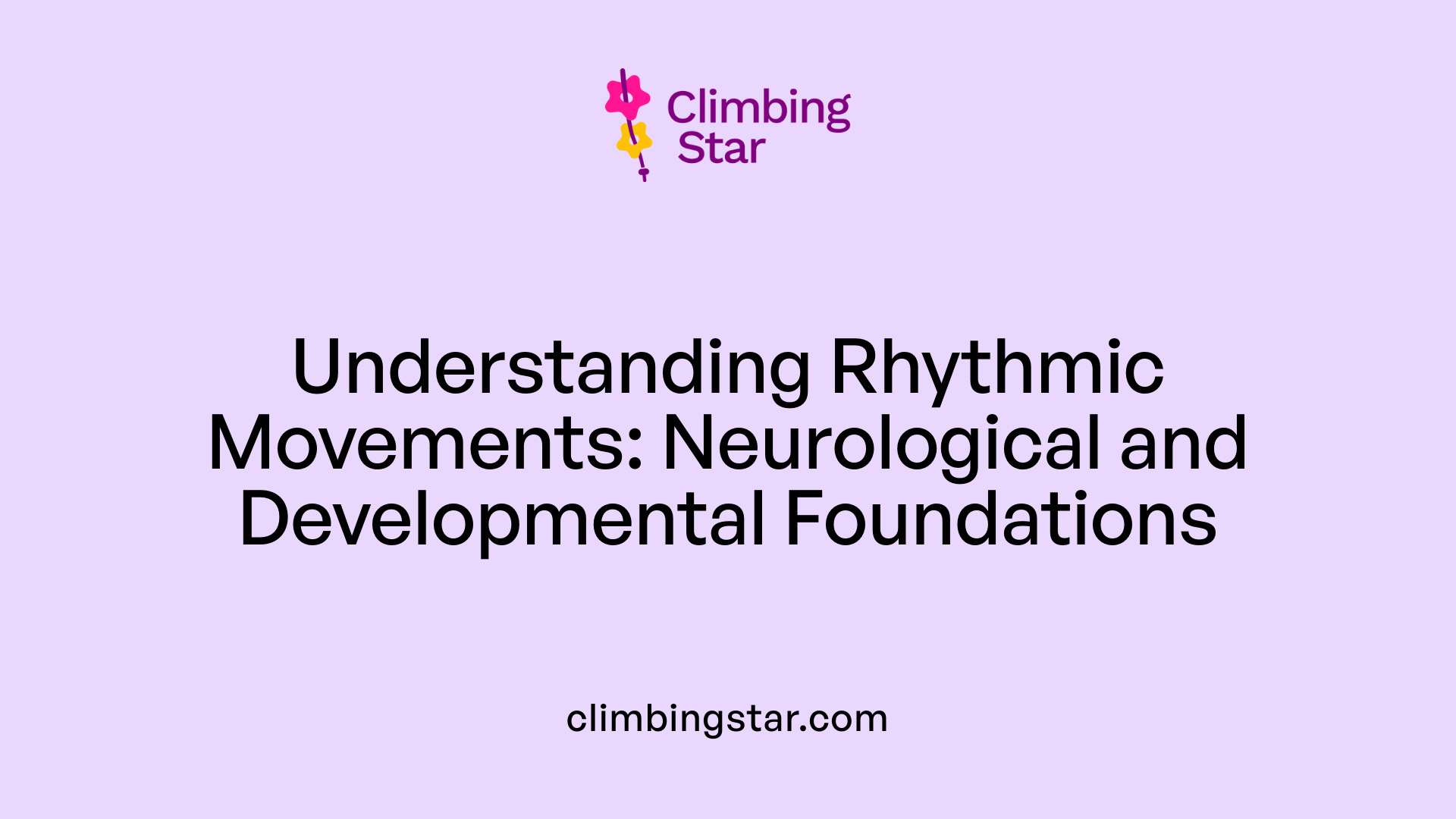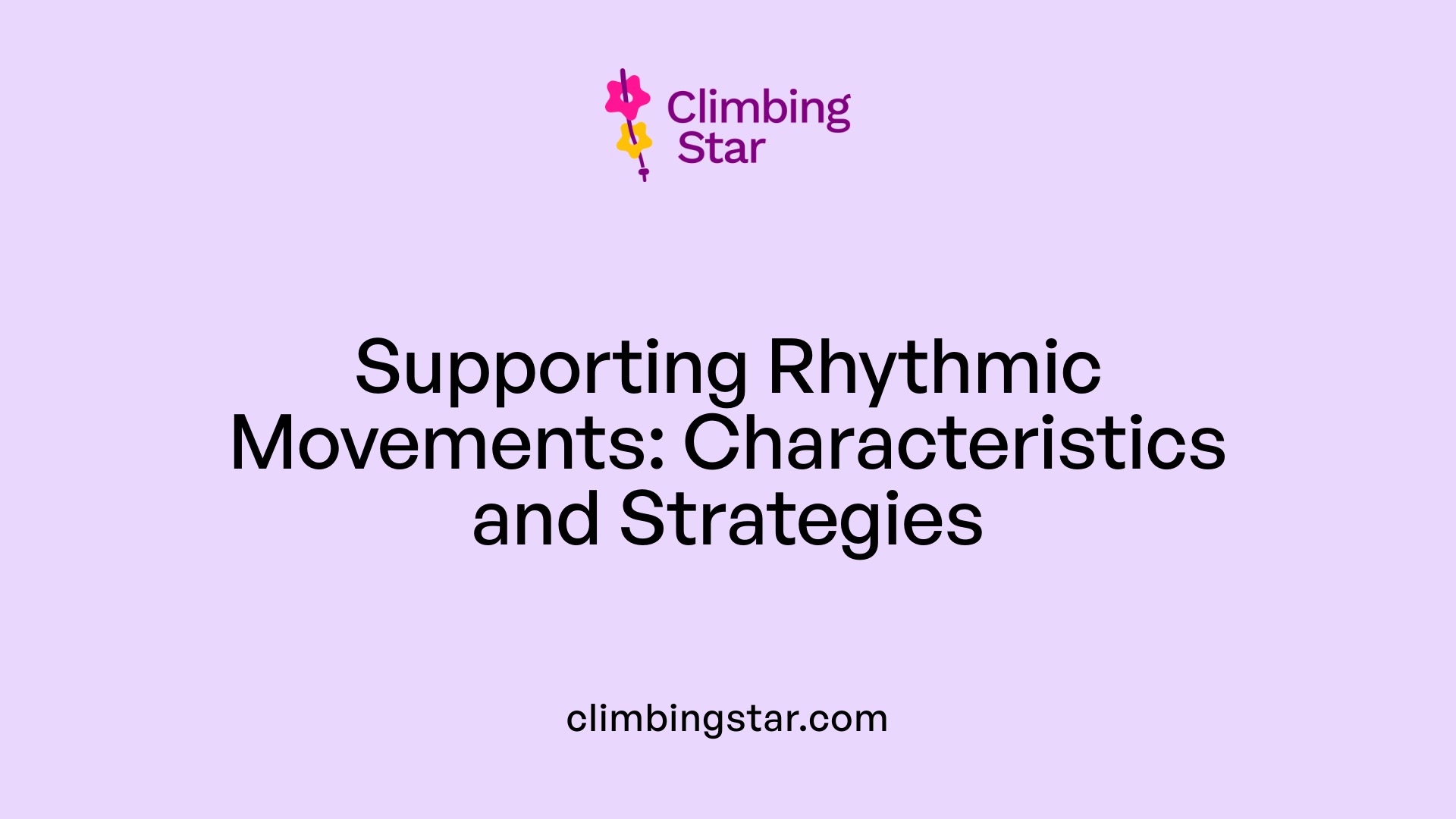Unraveling the Reasons Behind Self-Stimulatory Behaviors in Autism
Autistic individuals often engage in rhythmic movements such as rocking, spinning, and head banging. These behaviors, commonly known as 'stimming,' serve vital functions in sensory regulation, emotional expression, and coping strategies. This article explores why autistic people rock, the role of such movements as stim activities, and how understanding these behaviors can improve support and inclusion.
The Function of Rocking and Spinning as Self-Regulation Tools

Why do autistic people engage in rocking behaviors?
Autistic individuals often engage in rocking behaviors as a means of self-stimulation, or "stimming," which plays a crucial role in their sensory regulation. These repetitive motions help them manage overwhelming feelings and sensory input. Rocking can soothe anxiety, reduce stress, and provide sensory input across different modalities such as vestibular (balance), tactile (touch), and visual.
For many, rocking acts as a way to normalize sensory experiences, especially in environments that feel chaotic or overstimulating. It also offers a sense of comfort and control, serving as a nonverbal means of expressing emotions or seeking reassurance in unfamiliar or stressful situations. Sense sensitivities—either hypersensitivity or hyposensitivity—may make rocking particularly beneficial, as it can dampen sensory overload or provide necessary stimulation. Overall, these behaviors are vital self-regulation strategies that support emotional stability and sensory management.
What role do rocking and spinning activities play as stim behaviors in autism?
In autism, rocking and spinning serve as common forms of self-stimulatory behaviors, fundamental in helping individuals modulate their sensory experiences. These activities provide essential vestibular and other sensory input, which can prevent sensory overload or help calm feelings of anxiety.
Such stim behaviors are often used to promote focus, reduce stress, or self-soothe in response to emotional or environmental stimuli. For some, spinning or rocking can elevate mood or simply serve as a pleasurable sensory activity.
Understanding these behaviors allows caregivers and professionals to better support autistic individuals. While these stimming actions are often beneficial, managing them appropriately—including providing alternative sensory experiences—can enhance comfort and integration into social settings. For many, these activities are more than simple habits; they are vital tools in managing daily emotional and sensory challenges.
How these behaviors help manage sensory overload
Autistic individuals experience sensory stimuli differently, which can sometimes lead to overload or distress. Rocking and spinning behaviors help manage these intense sensations by either augmenting sensory input or providing a calming effect if they are hypersensitive.
By engaging in such rhythmic and repetitive movements, they can desensitize or buffer the impact of overwhelming stimuli, enabling better focus and emotional regulation. These self-stimulatory actions also serve as outlets for nervous energy, reducing the likelihood of meltdowns or withdrawal.
The importance of self-stimulation in emotional coping
Self-stimulation behaviors like rocking and spinning are not merely habits but essential mechanisms for emotional coping. They provide comfort during stressful circumstances, help in managing fears, or express joy.
Supporting these behaviors by understanding their purpose can improve overall well-being. It’s beneficial to recognize when such actions are helpful rather than disruptive, and to introduce sensory strategies that respect these needs.
Creating a supportive environment with sensory-friendly activities and routines can reduce the need for excessive stim behaviors. These strategies foster emotional resilience and support autistic individuals in daily life, enhancing their ability to interact and learn more effectively.
| Aspect | Description | Additional Notes |
|---|---|---|
| Sensory regulation | Using stim behaviors to manage sensory input | Helps with hypersensitivity or hyposensitivity |
| Emotional coping | Behaviors like rocking and spinning soothe stress | Offer comfort and emotional stability |
| Communication | May serve as nonverbal expression | Can signal needs or discomfort |
| Development of alternative strategies | Replacing disruptive stim behaviors | Use of sensory diets and activities for regulation |
Understanding the complex role of rocking and spinning in autism reveals how these behaviors are integral to sensory and emotional well-being. Recognizing their purpose enables more compassionate and effective support.
Understanding the Neurological and Developmental Bases of Rhythmic Movements

Differences between voluntary stim behaviors and rhythmic movement disorder (RMD)
Self-stimulatory behaviors, also known as 'stimming,' such as rocking, hand-flapping, or spinning, are often voluntary and serve functional roles for individuals with autism. They are typically ongoing during wakefulness and help in self-regulation, sensory exploration, or emotional management. These behaviors can be consciously performed or become ingrained as coping strategies.
In contrast, Rhythmic Movement Disorder (RMD) is a sleep-related condition characterized by involuntary, rhythmic movements such as head banging, body rocking, or rolling that occur during sleep, especially during the transition into sleep or during lighter sleep stages such as NREM. RMD generally affects young children and often diminishes by age 5. The key difference is that RMD movements are involuntary, typically occur during sleep, and can cause injury or sleep disturbances, whereas typical stim behaviors happen mainly during waking hours and are often voluntary.
Developmental aspects of self-stimulatory behaviors
Self-stimulatory behaviors often begin in early childhood, sometimes around age 1 or 2, as part of the sensory exploration phase. They serve important developmental functions by helping children regulate their sensory systems and emotions. For children with autism, these behaviors might become more persistent and complex over time, sometimes lasting into adolescence or adulthood.
As children grow, these behaviors can evolve. Younger children might engage in simple repetitive movements, whereas older children and adults might develop more focused or longer-lasting stim activities. These behaviors often reflect underlying sensory processing differences and can be reinforced by their calming or rewarding effects.
Age-related changes in rhythmic movements
In typical development, sleep-related rhythmic movements like RMD are most common in infants and toddlers. Most children outgrow RMD by age 5, with the behaviors becoming less frequent or disappearing altogether. With age, the neurological systems mature, and the need for such involuntary movements diminishes.
However, in some cases, rhythmic behaviors during sleep can persist longer, especially if associated with underlying conditions like ADHD or autism. For these individuals, behavioral and medical interventions might be needed to manage symptoms and ensure safe sleep environments.
Behaviors like rocking, whether voluntary during waking hours or involuntary during sleep, reflect the complex interplay of neurological, developmental, and sensory processing factors. Recognizing these differences helps in providing appropriate support and interventions.
| Aspect | Typical Development | Autism and RMD | Notes |
|---|---|---|---|
| Occurrence | During waking hours | During wakefulness or sleep | RMD mainly during sleep, stim behaviors mainly while awake |
| Voluntary/Involuntary | Usually voluntary | Often involuntary (RMD), sometimes voluntary (autism stim) | RMD is involuntary, stim is voluntary or habitual |
| Age | Early childhood | Birth through adulthood | RMD usually resolves by age 5 |
| Purpose | Self-exploration and learning | Self-regulation, sensory processing | Functions vary with individual needs |
| Developmental course | Decreases with age | May persist or evolve | Depends on underlying conditions |
Understanding these distinctions enhances our comprehension of how rhythmic movements and stim behaviors function neurologically and developmentally, informing better management and support strategies.
Characteristics and Support Strategies for Rhythmic Movement Behaviors

What are common characteristics and reasons behind rhythmic movement behaviors like rocking and spinning in autism?
Rhythmic movements such as rocking, spinning, head banging, or rolling are frequently observed behaviors among children with autism. These actions often serve as self-stimulatory activities that assist in sensory regulation, emotional calming, and organizing sensory input. More than 95% of children with autism experience sensory processing challenges, making these behaviors crucial for managing overwhelming sensory stimuli.
These movements offer predictable vestibular and proprioceptive stimulation, helping to stabilize the nervous system and enhance focus, mood, and coordination. For example, spinning or swinging provides rhythmic stimuli that can improve neural connectivity and support motor skills.
In addition to sensory benefits, rhythmic movements can facilitate social timing—improving interpersonal synchronization by making social interactions more comfortable. Therapeutic approaches like sensory integration therapy and Rhythmic Relating leverage these behaviors, aiming to enhance emotional regulation and social engagement. Overall, rhythmic movement behaviors are integral to how autistic individuals self-regulate and develop motor and sensory skills, rooted in neurological differences affecting movement and sensory processing.
What strategies can support individuals who engage in rocking behaviors?
Supporting those who engage in rocking or similar behaviors involves a combination of environmental modifications, alternative stim activities, and behavioral techniques.
Creating a sensory-friendly environment is essential. This could include using weighted blankets or vests to provide calming proprioceptive input, noise-canceling headphones to reduce auditory overload, and maintaining a predictable routine to lower stress triggers.
Offering alternative stim activities helps satisfy sensory needs in a less disruptive way. Examples include fidget toys, textured objects, clasping hands, or engaging in activities like swinging or bouncing that provide similar vestibular input in a controlled manner.
Teaching calming strategies such as deep breathing exercises, mindfulness practices, or self-soothing techniques can help individuals manage anxiety or sensory overload.
Working with professionals like occupational therapists or behavioral specialists can lead to personalized strategies. These experts can help develop plans that address the child's specific sensory and emotional needs while promoting safer behaviors.
Ultimately, respecting the individual's need for self-regulation is vital. While guiding them toward adaptive behaviors, it’s essential to avoid unnecessary attention to the rocking, which might reinforce the activity unintentionally. Supporting emotional well-being and offering adaptive options foster comfort, emotional stability, and better integration of sensory experiences.
Embracing Self-Stimulation in Autism
Understanding why autistic people rock and engage in other rhythmic movements reveals their vital role in sensory regulation, emotional stability, and communication. Recognizing these behaviors as meaningful and functional allows caregivers, educators, and clinicians to support individuals in ways that respect their needs while promoting well-being. By creating sensory-friendly environments, teaching alternative coping strategies, and fostering acceptance, society can help autistic individuals thrive emotionally and socially. Embracing self-stimulatory behaviors as a core part of autism not only fosters compassion but also enriches our understanding of the diverse ways the brain experiences and interacts with the world.
References
- Why Do Children with Autism Like Spinning Around in ...
- Sleep-related Rhythmic Movement Disorder (RMD)
- Reducing Self-stimulatory Behaviors in Individuals with ...
- What Is Stimming in ADHD and Autism?
- The Purpose of Stimming: Why Children Stim?
- Reducing Self-stimulatory Behaviors in Individuals with ...
- How To Identify Self-Soothing Behaviors in Children with ...
- Repeated movements and behaviour (stimming)







